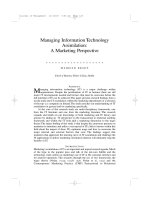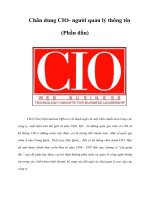Kỹ thuật quản lý thông tin đồng hóa một phối cảnh Marketing
Bạn đang xem bản rút gọn của tài liệu. Xem và tải ngay bản đầy đủ của tài liệu tại đây (75.06 KB, 14 trang )
Managing Information Technology
Assimilation:
A Marketing Perspective
School of Business,Trinity College, Dublin
A
BSTRACT
M
anaging information technology (IT) is a major challenge within
organisations. Despite the proliferation of IT in business there are still
major IT developments needed and barriers that must be overcome before the
full potential of IT can be achieved.This paper presents research findings from a
recent study into IT assimilation within the marketing departments of a selection
of the top companies in Ireland.The study enriches our understanding of IT
assimilation in general and for marketing specifically.
At the core of this research study are multi-disciplinary frameworks, one
from the IT literature and one from the marketing literature. This research
expands and builds on our knowledge of both marketing and IT theory and
practice by adding an IT perspective to the transactional to relational marking
framework and within the IT field adds a marketing dimension to the stages
theory.The major finding of this study is that despite the enormous pressure on
marketers to introduce and utilise a vast myriad of ITs, little is known within this
field about the impact of these ITs, optimum usage and how to overcome the
major internal and external barriers that exist. The findings suggest that
marketers that appreciate the learning curve of IT assimilation and challenge the
IT applications to deliver marketing-orientated solutions will ultimately reap the
benefits of IT.
I
NTRODUCTION
Marketing’s assimilation of IT is an important and topical research agenda. Much
of the hype in the popular press and talk of the dot.com bubble and the
technology crash centres on marketing’s use of IT at the customer interface and
for internal operations. This research, through the use of two frameworks, the
stages theory (Nolan, a; b; ; Nolan et al., ) and the
Contemporary Marketing Practice (CMP) Transactional to Relational
Journal of Management 11/12/03 5:05 pm Page 125
Marketing Framework (Brodie et al., ; Coviello et al., ; a; b;
; Coviello and Brodie, ) contributes to the ongoing debate in this area
and provides empirically supported observations on the reality of contemporary
marketing practice and IT assimilation. The core finding is that IT is not the
wonder drug of the s and IT assimilations take time to mature. Technical
revolutions have always taken time to develop fully, as they force people and
organisations to change current behaviour and/or learn new skills (Perez, ).
This paper commences with a discussion of the role of IT in marketing and
reviews the frameworks which were used to research the assimilation of IT
within marketing. This is followed by a description of the case study research
design chosen for the study.The subsequent section explores the findings from
the study, which are documented through the use of two of the research
propositions.The paper concludes with the practical and theoretical implications
of this study.
T
HE
R
OLE OF
IT
IN
M
ARKETING
IT has played a critical role in business over the past ten years, as its assimilation
progressed within and across departments and organisations.The investment in
IT during the s can be classed as the pivotal investment made by companies,
with IT representing over per cent of all business equipment investments
(King, ; Margherio et al., ). In general, IT implementations have had a
dominant automational focus on internal productivity centred on the
manufacturing and finance functions, which has seen their efficiencies increase
(Sheth and Sisodia, ; Galliers and Baets, ). Empirical studies reveal that
IT use in marketing is also predominantly for productivity or automational
purposes (Domegan and Donaldson, ; Palihawadana and Delfino, ;
Bruce et al., ; Fletcher and Wright, ; Leverick et al., ; ).
Leverick et al. (: ) suggest that “far from the radical transformation of
marketing promised by IT, the use of IT for marketing has thus far focused
primarily on the routine and tactical activities”.Their research findings showed
that IT exists, but that it has not been exploited within marketing.Willcocks and
Lester’s () study also confirmed that the majority of IT investments were
aimed at achieving internal efficiencies.The challenge for marketing is to move
from the discrete approach (parallel tasks), viewing IT as an administration tool,
to a strategic marketing approach with a clear understanding of IT and the way
it should be exploited (Holtham, ).
Within marketing, there have been limited attempts to classify ITs
(McDonald and Wilson, ; Brady et al., b).The major difficulty is that
there are hundreds of IT applications and a myriad of Internet- and
telecommunication-based IT applications targeted at marketing, which could be
classed as IT usage in marketing (Holtham, ; Marchall, ; Leverick et al.,
).
This research is focused on the totality of IT within the marketing
department rather than a study of an individual IT. IT should be viewed as a
whole system rather than as separate technologies (Ford and Saren, ;
Managing Information Technology Assimilation:A Marketing Perspective
Journal of Management 11/12/03 5:05 pm Page 126
THE IRISH JOURNAL OF MANAGEMENT
Willcocks, ; Galliers and Baets, ; King, ; MacKenzie and Wajcman,
). The trend in isolating and researching ITs individually ignores the
collective and cumulative impact of IT in marketing, which a holistic view
provides. The majority of current studies focuses on individual ITs and their
impact on separate or selected parts of marketing operations. For example, there
are articles which focuses on the Internet (Kierzkowski et al., ; Sahay et al.,
; Dutta and Segev, ; Geiger and Martin, ); marketing information
systems (Higby and Farah, ; Li, ;Talvinen and Saarinen, ); databases
(Fletcher and Wright, ; Desai et al., ); customer relationship
management software (SAS Institute, ; Dempsey, ; Payne, ); and
self-service technologies (Freeman and Sudoyo, ; Meuter et al., ).The
findings from these studies confirm that marketers are struggling to assimilate
individual ITs and thus it can be assumed that this will be compounded when
the ITs are studied collectively.
IT is viewed by managers in ‘clusters’ and it should be researched in that
format (Clarke et al., ). Willcocks and Lester (: ) observed that in
reality this does not happen and they noted as a major finding of their study “that
only per cent of organisations surveyed, included the totality of systems
availability and capability and the needs of the organisation and department, in
their assessment”.This is a pivotal issue for marketing, where, due to the multi-
operational nature of IT and the nature of marketing operations, a singular IT
resource can be used for a variety of marketing operations and across various
departments (Barnes, ).
As a direct response to the above discussion the research focus for this study
included a list of over ITs within marketing, grouped under the following
headings:
•
Analysis, planning, implementation and control applications;
•
Communication devices both internally and to a range of external entities;
•
Segmentation and targeting software including databases;
•
Self service technologies used by customers;
•
Research technologies;
•
Sales force related technologies.
S
TAGES
T
HEORY OF
IT A
SSIMILATION
To study IT assimilation in marketing, academics must be aware of developments
which exist in other disciplines. Much work has been carried out in the area of
IT assimilation over the last three decades.There are a plethora of IT evaluation
techniques (Brady et al., ) and following a review of evaluation and
assimilation models, the stages theory of IT assimilation (Nolan, a; b;
; Nolan et al., ) which offers interesting insights into the assimilation
process (see Figure .), was chosen for this study. This is the most cited and
empirically tested model in the IT literature (Galliers and Sunderland, ).
Journal of Management 11/12/03 5:05 pm Page 127
Figure . Stages Theory of IT Assimilation
1960/1970 1980 1990 2000 2010
Source: Adapted from Nolan (1973) and Zuboff (1988).
Numerous authors have suggested stages of IT assimilation in companies
(Haeckel, ; Zuboff, ; Davenport; ; Cash et al., ; Mooney et al.,
; Farbey et al., ) and for marketing purposes (Hammer and Mangurian,
; Baker, ; Peattie and Peters, ), though there has been no empirical
study of this framework for marketing purposes.
The stages theory suggests that IT is assimilated over time. Therefore, in
order for marketing managers to effectively assimilate IT into their operations,
they must understand the defining dimensions of this framework, that there is a
diffusion process and that organisational learning is a critical component needed
in order to progress the assimilation through the stages.These stages can be linked
to the broad eras of technological developments (Perez and Freeman, ;
Butler et al., ) and technological innovations models (Dosi, ; Durand,
).
Utilising the three stages of automation, information and transformation,
coined by Zuboff (), at the introduction stage IT will be used for
automational purposes, replacing manual tasks, at the second stage for
informational purposes, resulting in increased effectiveness, and at the third stage
there will be transformation. It is worth nothing that Haeckel (), in his
development of a stages theory view of IT assimilation in marketing, referred to
the third stage as unthinkable, highlighting the level of confusion surrounding
the future developments of IT. Reviewing the timeline (see Figure .),it is clear
that we are at the informational stage of IT assimilation (Nolan, ) rather than
the transformational stage, despite the commentary in the popular press and
many business journals over the last decade.
Managing Information Technology Assimilation:A Marketing Perspective
Data Processing Era
Transformation
Micro Computing
Automation
Network Era
Information
Organisational Learning
High
Low
Journal of Management 11/12/03 5:05 pm Page 128
THE IRISH JOURNAL OF MANAGEMENT
C
ONTEMPORARY
M
ARKETING
P
RACTICE
F
RAMEWORK
Researchers have long endeavoured to classify marketing practice and one
framework which has achieved academic support is the CMP transactional to
relational framework (Brodie et al., ; Coviello et al., ; a; b;
Coviello and Brodie, ). The authors suggest that there are four dominant
approaches to marketing within companies (transactional, database, interaction
and network marketing) and twelve relational exchange and managerial
dimensions for each approach (see Table .).This framework, which has been
empirically tested (Brodie et al., ; Lindgreen, ), suggests that there can
be a pluralism of marketing approaches within companies (Pels et al., ;
Coviello and Brodie, ).
Table . Marketing Approaches Classified by Relational Exchange
and Managerial Dimensions
Transactional Relational
Transaction Database Interaction Network
Marketing Marketing Marketing Marketing
Relational Exchange Dimensions
Focus
Parties involved
Communication patterns
Type of contact
Duration
Formality
Balance of power
Managerial Dimension
Managerial intent
Decision focus
Managerial investment
Managerial level
Time frame
Source: Adapted from Coviello et al. (1997).
As evidenced in Table ., there is a lack of an IT dimension to this framework,
though in a further development, Coviello et al. (a; b) did add e-
marketing as a fifth approach. This framework was utilised for the research to
ascertain whether IT had a role within marketing approaches.
R
ESEARCH
M
ETHODOLOGY
Following from the literature review the following research objective was
developed.
IT assimilation in marketing practice occurs in stages and there is an IT dimension to the
(CMP) transactional to relational framework.
Journal of Management 11/12/03 5:05 pm Page 129









